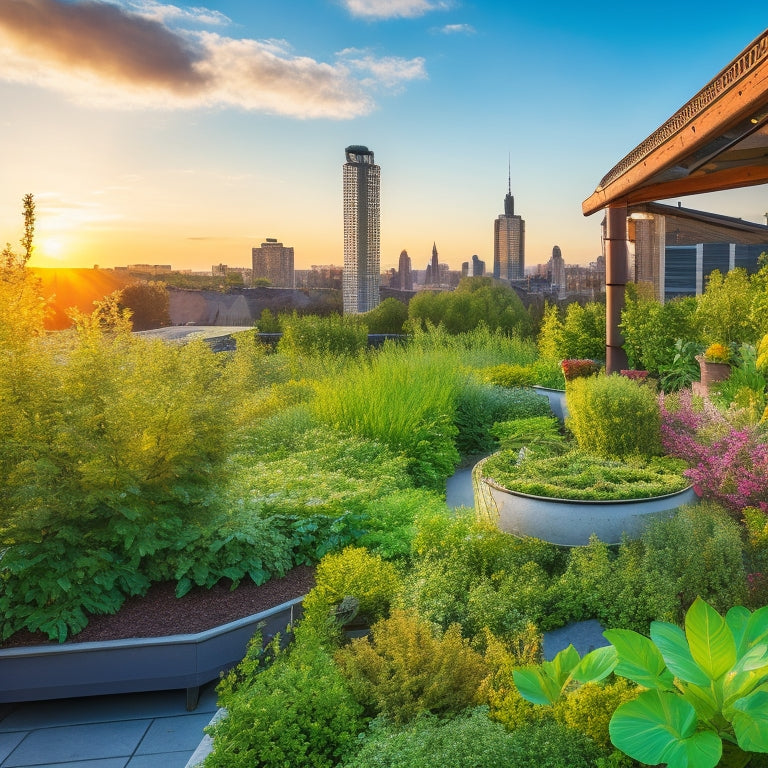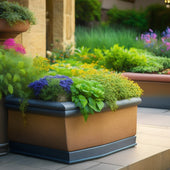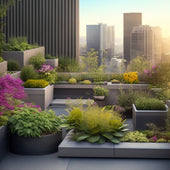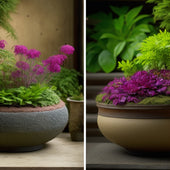
Top 3 Rooftop Hydroponic Irrigation Systems for Success
Share
When selecting a rooftop hydroponic irrigation system, you'll want to prioritize efficient water delivery, precise nutrient supply, and ideal oxygenation for high crop yields and minimal waste. Consider systems that incorporate drip irrigation, misting, and precision irrigation controllers to deliver specific nutrient amounts at scheduled times. Additionally, evaluate smart controllers that integrate with sensors, automate scheduling, and adjust based on weather forecasts. By choosing the right system, you'll reduce water waste and lower your water bills. Now, discover the top three rooftop hydroponic irrigation systems that excel in these criteria and take your rooftop garden to the next level.
Key Takeaways
• Opt for precision irrigation controllers that deliver specific nutrient amounts at scheduled times to promote healthy crop growth and reduce water waste.
• Select a rooftop hydroponic irrigation system that considers plant spacing, growth rates, and nutrient needs for optimal performance.
• Implement water conservation techniques like drip irrigation and misting systems to minimize water waste and lower water bills.
• Choose a system with real-time moisture monitoring and automated scheduling to ensure efficient water and nutrient delivery.
• Consider the automation level, system complexity, and technical support availability when selecting a rooftop hydroponic irrigation system.
Efficient Water Delivery Systems
In a rooftop hydroponic irrigation system, you need a reliable and efficient water delivery system that can supply plants with the right amount of water, nutrients, and oxygen at the right time to optimize growth and minimize waste. This is vital to guarantee healthy plant development and maximize crop yields.
To achieve this, you'll want to implement water conservation techniques, such as using drip irrigation or misting systems, which reduce water evaporation and runoff. Additionally, you should consider incorporating nutrient delivery methods that provide plants with the necessary nutrients at the right time.
This can be done through the use of precision irrigation controllers, which can be programmed to deliver specific amounts of nutrients to plants at specific times. By optimizing your water delivery system, you can reduce water waste, lower your water bill, and create a more sustainable rooftop hydroponic irrigation system.
Rooftop Hydroponic Irrigation Designs
You'll need to select a rooftop hydroponic irrigation design that complements your water delivery system, taking into account factors such as plant spacing, growth rates, and nutrient requirements.
A well-designed irrigation system guarantees uniform distribution of nutrient solutions to your crops, promoting healthy growth and maximizing yields.
For rooftop hydroponic systems, vertical gardening is a popular design approach, where plants are stacked vertically to optimize space. This design allows for efficient use of water and nutrients, as well as easier monitoring and maintenance.
When choosing an irrigation design, evaluate the type of crops you're growing, their growth rates, and their nutrient requirements. For example, leafy greens require more frequent watering than fruiting crops like tomatoes.
You'll also need to assess the flow rate, pressure, and piping layout to guarantee that your system can handle the demands of your crops.
Smart Irrigation Controllers Compared
Compare smart irrigation controllers by evaluating their features, such as real-time moisture monitoring, automated scheduling, and weather data integration, to determine which one best suits your rooftop hydroponic irrigation system's specific needs.
You'll want to contemplate controllers that integrate with smart sensors, which provide accurate and timely data on soil moisture levels, temperature, and other environmental factors. This information enables irrigation automation, ensuring your plants receive the right amount of water and nutrients at the right time.
When evaluating controllers, look for features like customizable scheduling, remote monitoring, and alerts for unusual water usage or system malfunctions. Some advanced controllers can even adjust irrigation schedules based on weather forecasts, reducing water waste and preventing overwatering.
Reflect on the level of automation you need, as well as the complexity of the system and the level of technical support provided. By carefully evaluating these factors, you can choose a smart irrigation controller that optimizes your rooftop hydroponic irrigation system's performance, reduces water consumption, and increases crop yields.
Frequently Asked Questions
How Often Should I Clean My Rooftop Hydroponic Irrigation System?
As you're probably aware, a neglected rooftop hydroponic system can quickly turn into a breeding ground for bacteria and algae, which is why you should clean it every 1-2 weeks to guarantee peak system longevity and prevent clogs.
Are Rooftop Hydroponic Gardens Susceptible to Wind Damage?
You need to take into account wind resistance when designing your rooftop hydroponic garden, ensuring it has sufficient structural support to withstand gusts and gales, as wind damage can be detrimental to your entire system.
Can I Use Rainwater for My Rooftop Hydroponic Irrigation System?
'As you bask in the rooftop garden's serene ambiance, you wonder: can you harness the sky's bounty for irrigation? Yes, you can use rainwater, but be prepared to tackle rainwater harvesting and precise nutrient management to guarantee a thriving crop.'
Do Rooftop Hydroponic Irrigation Systems Require a Lot of Maintenance?
You'll find that rooftop hydroponic irrigation systems require regular maintenance to guarantee system efficiency, but with tips like daily monitoring, weekly cleaning, and monthly system checks, you can minimize downtime and optimize performance.
Are Rooftop Hydroponic Gardens More Expensive Than Traditional Gardens?
Just as a master chef weighs the cost of fresh ingredients against the value of a exquisite dish, you'll find that rooftop hydroponic gardens may have a higher upfront cost, but offer long-term savings through efficient resource use and increased yields.
Related Posts
-

5 Essential Drainage Tips for Block Planters
When using block planters, you'll want to guarantee effective drainage to prevent waterlogging and root rot. Start by...
-

5 Essential Drainage Tips for Block Planters
When using block planters, you'll want to guarantee effective drainage to prevent waterlogging and root rot. Start by...
-

5 Essential Drainage Tips for Block Planters
When using block planters, you'll want to guarantee effective drainage to prevent waterlogging and root rot. Start by...
-

5 Essential Drainage Tips for Block Planters
When using block planters, you'll want to guarantee effective drainage to prevent waterlogging and root rot. Start by...
-

5 Essential Drainage Tips for Block Planters
When using block planters, you'll want to guarantee effective drainage to prevent waterlogging and root rot. Start by...
-

5 Essential Drainage Tips for Block Planters
When using block planters, you'll want to guarantee effective drainage to prevent waterlogging and root rot. Start by...
-

5 Essential Drainage Tips for Block Planters
When using block planters, you'll want to guarantee effective drainage to prevent waterlogging and root rot. Start by...
-

5 Essential Drainage Tips for Block Planters
When using block planters, you'll want to guarantee effective drainage to prevent waterlogging and root rot. Start by...
-

5 Essential Drainage Tips for Block Planters
When using block planters, you'll want to guarantee effective drainage to prevent waterlogging and root rot. Start by...
-

5 Essential Drainage Tips for Block Planters
When using block planters, you'll want to guarantee effective drainage to prevent waterlogging and root rot. Start by...
-

5 Essential Drainage Tips for Block Planters
When using block planters, you'll want to guarantee effective drainage to prevent waterlogging and root rot. Start by...
-

5 Essential Drainage Tips for Block Planters
When using block planters, you'll want to guarantee effective drainage to prevent waterlogging and root rot. Start by...
-

5 Essential Drainage Tips for Block Planters
When using block planters, you'll want to guarantee effective drainage to prevent waterlogging and root rot. Start by...
-

5 Essential Drainage Tips for Block Planters
When using block planters, you'll want to guarantee effective drainage to prevent waterlogging and root rot. Start by...
-

5 Essential Drainage Tips for Block Planters
When using block planters, you'll want to guarantee effective drainage to prevent waterlogging and root rot. Start by...
-

5 Essential Drainage Tips for Block Planters
When using block planters, you'll want to guarantee effective drainage to prevent waterlogging and root rot. Start by...
-

5 Essential Drainage Tips for Block Planters
When using block planters, you'll want to guarantee effective drainage to prevent waterlogging and root rot. Start by...
-

5 Essential Drainage Tips for Block Planters
When using block planters, you'll want to guarantee effective drainage to prevent waterlogging and root rot. Start by...
-

Irrigation System Design Ideas for Concrete Planters
As you design an irrigation system for your concrete planters, you'll need to balance drainage, moisture retention, a...
-

Irrigation System Design Ideas for Concrete Planters
As you design an irrigation system for your concrete planters, you'll need to balance drainage, moisture retention, a...
-

Irrigation System Design Ideas for Concrete Planters
As you design an irrigation system for your concrete planters, you'll need to balance drainage, moisture retention, a...
-

Irrigation System Design Ideas for Concrete Planters
As you design an irrigation system for your concrete planters, you'll need to balance drainage, moisture retention, a...
-

Irrigation System Design Ideas for Concrete Planters
As you design an irrigation system for your concrete planters, you'll need to balance drainage, moisture retention, a...
-

Irrigation System Design Ideas for Concrete Planters
As you design an irrigation system for your concrete planters, you'll need to balance drainage, moisture retention, a...
-

Irrigation System Design Ideas for Concrete Planters
As you design an irrigation system for your concrete planters, you'll need to balance drainage, moisture retention, a...
-

Irrigation System Design Ideas for Concrete Planters
As you design an irrigation system for your concrete planters, you'll need to balance drainage, moisture retention, a...
-

Irrigation System Design Ideas for Concrete Planters
As you design an irrigation system for your concrete planters, you'll need to balance drainage, moisture retention, a...
-

Irrigation System Design Ideas for Concrete Planters
As you design an irrigation system for your concrete planters, you'll need to balance drainage, moisture retention, a...
-

Irrigation System Design Ideas for Concrete Planters
As you design an irrigation system for your concrete planters, you'll need to balance drainage, moisture retention, a...
-

Irrigation System Design Ideas for Concrete Planters
As you design an irrigation system for your concrete planters, you'll need to balance drainage, moisture retention, a...
-

Irrigation System Design Ideas for Concrete Planters
As you design an irrigation system for your concrete planters, you'll need to balance drainage, moisture retention, a...
-

Irrigation System Design Ideas for Concrete Planters
As you design an irrigation system for your concrete planters, you'll need to balance drainage, moisture retention, a...
-

Irrigation System Design Ideas for Concrete Planters
As you design an irrigation system for your concrete planters, you'll need to balance drainage, moisture retention, a...
-

Irrigation System Design Ideas for Concrete Planters
As you design an irrigation system for your concrete planters, you'll need to balance drainage, moisture retention, a...
-

Irrigation System Design Ideas for Concrete Planters
As you design an irrigation system for your concrete planters, you'll need to balance drainage, moisture retention, a...
-

Irrigation System Design Ideas for Concrete Planters
As you design an irrigation system for your concrete planters, you'll need to balance drainage, moisture retention, a...
-

Irrigation System Design Ideas for Concrete Planters
As you design an irrigation system for your concrete planters, you'll need to balance drainage, moisture retention, a...
-

Irrigation System Design Ideas for Concrete Planters
As you design an irrigation system for your concrete planters, you'll need to balance drainage, moisture retention, a...
-

Irrigation System Design Ideas for Concrete Planters
As you design an irrigation system for your concrete planters, you'll need to balance drainage, moisture retention, a...
-

Irrigation System Design Ideas for Concrete Planters
As you design an irrigation system for your concrete planters, you'll need to balance drainage, moisture retention, a...
-

Irrigation System Design Ideas for Concrete Planters
As you design an irrigation system for your concrete planters, you'll need to balance drainage, moisture retention, a...
-

Irrigation System Design Ideas for Concrete Planters
As you design an irrigation system for your concrete planters, you'll need to balance drainage, moisture retention, a...
-

Irrigation System Design Ideas for Concrete Planters
As you design an irrigation system for your concrete planters, you'll need to balance drainage, moisture retention, a...
-

Irrigation System Design Ideas for Concrete Planters
As you design an irrigation system for your concrete planters, you'll need to balance drainage, moisture retention, a...
-

Irrigation System Design Ideas for Concrete Planters
As you design an irrigation system for your concrete planters, you'll need to balance drainage, moisture retention, a...
-

Irrigation System Design Ideas for Concrete Planters
As you design an irrigation system for your concrete planters, you'll need to balance drainage, moisture retention, a...
-

Irrigation System Design Ideas for Concrete Planters
As you design an irrigation system for your concrete planters, you'll need to balance drainage, moisture retention, a...
-

Irrigation System Design Ideas for Concrete Planters
As you design an irrigation system for your concrete planters, you'll need to balance drainage, moisture retention, a...
-

Irrigation System Design Ideas for Concrete Planters
As you design an irrigation system for your concrete planters, you'll need to balance drainage, moisture retention, a...
-

What to Seal Your Planters With for Longevity
When sealing your planters for longevity, it's vital to choose a sealant compatible with your planter material - whet...
-

What to Seal Your Planters With for Longevity
When sealing your planters for longevity, it's vital to choose a sealant compatible with your planter material - whet...
-

What to Seal Your Planters With for Longevity
When sealing your planters for longevity, it's vital to choose a sealant compatible with your planter material - whet...
-

What to Seal Your Planters With for Longevity
When sealing your planters for longevity, it's vital to choose a sealant compatible with your planter material - whet...
-

What to Seal Your Planters With for Longevity
When sealing your planters for longevity, it's vital to choose a sealant compatible with your planter material - whet...
-

What to Seal Your Planters With for Longevity
When sealing your planters for longevity, it's vital to choose a sealant compatible with your planter material - whet...
-

What to Seal Your Planters With for Longevity
When sealing your planters for longevity, it's vital to choose a sealant compatible with your planter material - whet...
-

What to Seal Your Planters With for Longevity
When sealing your planters for longevity, it's vital to choose a sealant compatible with your planter material - whet...
-

What to Seal Your Planters With for Longevity
When sealing your planters for longevity, it's vital to choose a sealant compatible with your planter material - whet...
-

What to Seal Your Planters With for Longevity
When sealing your planters for longevity, it's vital to choose a sealant compatible with your planter material - whet...
-

What to Seal Your Planters With for Longevity
When sealing your planters for longevity, it's vital to choose a sealant compatible with your planter material - whet...
-

What to Seal Your Planters With for Longevity
When sealing your planters for longevity, it's vital to choose a sealant compatible with your planter material - whet...
-

What to Seal Your Planters With for Longevity
When sealing your planters for longevity, it's vital to choose a sealant compatible with your planter material - whet...
-

What to Seal Your Planters With for Longevity
When sealing your planters for longevity, it's vital to choose a sealant compatible with your planter material - whet...
-

What to Seal Your Planters With for Longevity
When sealing your planters for longevity, it's vital to choose a sealant compatible with your planter material - whet...
-

What to Seal Your Planters With for Longevity
When sealing your planters for longevity, it's vital to choose a sealant compatible with your planter material - whet...
-

What to Seal Your Planters With for Longevity
When sealing your planters for longevity, it's vital to choose a sealant compatible with your planter material - whet...
-

What to Seal Your Planters With for Longevity
When sealing your planters for longevity, it's vital to choose a sealant compatible with your planter material - whet...
-

What to Seal Your Planters With for Longevity
When sealing your planters for longevity, it's vital to choose a sealant compatible with your planter material - whet...
-

What to Seal Your Planters With for Longevity
When sealing your planters for longevity, it's vital to choose a sealant compatible with your planter material - whet...
-

What to Seal Your Planters With for Longevity
When sealing your planters for longevity, it's vital to choose a sealant compatible with your planter material - whet...
-

What to Seal Your Planters With for Longevity
When sealing your planters for longevity, it's vital to choose a sealant compatible with your planter material - whet...
-

What to Seal Your Planters With for Longevity
When sealing your planters for longevity, it's vital to choose a sealant compatible with your planter material - whet...
-

What to Seal Your Planters With for Longevity
When sealing your planters for longevity, it's vital to choose a sealant compatible with your planter material - whet...
-

What to Seal Your Planters With for Longevity
When sealing your planters for longevity, it's vital to choose a sealant compatible with your planter material - whet...
-

What to Seal Your Planters With for Longevity
When sealing your planters for longevity, it's vital to choose a sealant compatible with your planter material - whet...
-

What to Seal Your Planters With for Longevity
When sealing your planters for longevity, it's vital to choose a sealant compatible with your planter material - whet...
-

What to Seal Your Planters With for Longevity
When sealing your planters for longevity, it's vital to choose a sealant compatible with your planter material - whet...
-

What to Seal Your Planters With for Longevity
When sealing your planters for longevity, it's vital to choose a sealant compatible with your planter material - whet...
-

What to Seal Your Planters With for Longevity
When sealing your planters for longevity, it's vital to choose a sealant compatible with your planter material - whet...
-

What to Seal Your Planters With for Longevity
When sealing your planters for longevity, it's vital to choose a sealant compatible with your planter material - whet...
-

What to Seal Your Planters With for Longevity
When sealing your planters for longevity, it's vital to choose a sealant compatible with your planter material - whet...


